《机器维修工程学》课程授课教案(英文)How does a carburetor work
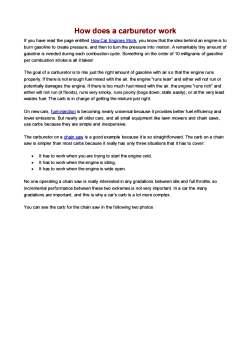
HowdoesacarburetorworkIf youhavereadthepageentitledHowCarEnginesWork,youknowthattheideabehindanengineistoburngasolineto createpressure,andthentoturnthepressure into motion.Aremarkablytinyamountofgasoline is needed during each combustion cycle. Something on the order of 10milligrams of gasolinepercombustionstrokeisall ittakes!The goal of a carburetor is to mix just the right amount of gasoline with air so that the engine runsproperly. If there is not enough fuel mixed with the air, the engine "runs lean" and either will not run orpotentially damages the engine. If there is too much fuel mixed with the air,the engine"runs rich"andeither will not run (it floods),runs very smoky,runs poorly (bogs down, stalls easily), or at the very leastwastes fuel.The carb is in charge of getting the mixture just right.On newcars,fuel iniection is becomingnearly universal because it providesbetterfuelefficiencyandlower emissions. But nearly all older cars, and all small equipment like lawn mowers and chain saws.usecarbsbecausetheyaresimpleandinexpensive.The carburetor on a chain saw is a good example because it is so straightforward. The carb on a chainsawissimplerthanmostcarbsbecauseitrealyhasonlythreesituationsthatithastocoverIt has to work when you are trying to start the engine cold.It has to work when the engine is idling.It has to work when the engine is wide openNo one operating a chain saw is really interested in any gradations between idle and full throttle, soincremental performance between these two extremes is not very important. In a car the manygradations are important, and this is whya car's carb is a lot more complex.Youcanseethecarbforthechainsaw in thefollowingtwophotos
How does a carburetor work If you have read the page entitled How Car Engines Work, you know that the idea behind an engine is to burn gasoline to create pressure, and then to turn the pressure into motion. A remarkably tiny amount of gasoline is needed during each combustion cycle. Something on the order of 10 milligrams of gasoline per combustion stroke is all it takes! The goal of a carburetor is to mix just the right amount of gasoline with air so that the engine runs properly. If there is not enough fuel mixed with the air, the engine "runs lean" and either will not run or potentially damages the engine. If there is too much fuel mixed with the air, the engine "runs rich" and either will not run (it floods), runs very smoky, runs poorly (bogs down, stalls easily), or at the very least wastes fuel. The carb is in charge of getting the mixture just right. On new cars, fuel injection is becoming nearly universal because it provides better fuel efficiency and lower emissions. But nearly all older cars, and all small equipment like lawn mowers and chain saws, use carbs because they are simple and inexpensive. The carburetor on a chain saw is a good example because it is so straightforward. The carb on a chain saw is simpler than most carbs because it really has only three situations that it has to cover: • It has to work when you are trying to start the engine cold. • It has to work when the engine is idling. • It has to work when the engine is wide open. No one operating a chain saw is really interested in any gradations between idle and full throttle, so incremental performance between these two extremes is not very important. In a car the many gradations are important, and this is why a car's carb is a lot more complex. You can see the carb for the chain saw in the following two photos
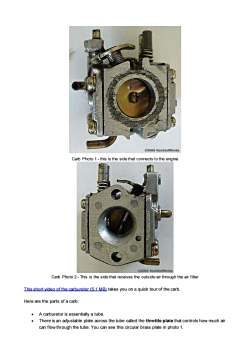
e2000HowstufrWorksCarb Photo1-this is thesidethat connectsto theengine@20ooHowstufrWorkCarb Photo2-This is the sidethatreceives the outsideair throughtheair filterThisshortvideoofthecarburetor(5.1MB)takesyouonaquicktourofthecarbHerearethepartsofacarb:AcarburetorisessentiallyatubeThereisanadjustableplateacrossthetubecalledthethrottleplatethatcontrolshowmuchaircanflowthroughthetube.Youcanseethiscircularbrassplateinphoto1
Carb Photo 1 - this is the side that connects to the engine Carb Photo 2 - This is the side that receives the outside air through the air filter This short video of the carburetor (5.1 MB) takes you on a quick tour of the carb. Here are the parts of a carb: • A carburetor is essentially a tube. • There is an adjustable plate across the tube called the throttle plate that controls how much air can flow through the tube. You can see this circular brass plate in photo 1
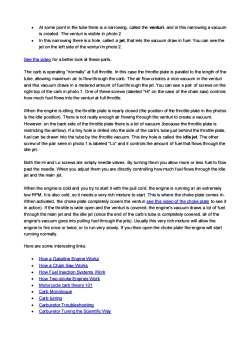
At some pointin the tube there is a narrowing, called the venturi, and in this narrowing a vacuumis created.The venturis visible in photo 2In this narrowing thereis a hole, called a jet,thatlets the vacuum draw in fuel.You can see thejetontheleftsideoftheventurinphoto2.See the videoforabetterlook at thesepartsThe carb is operating "normally" at full throttle. In this case the throttle plate is parallel to the length of thetube,allowingmaximumairtoflowthroughthecarb.Theairflowcreatesanicevacuumintheventuriandthisvacuumdrawsinameteredamountoffuelthroughthe jet.Youcanseeapairofscrewsontherighttopofthecarbinphoto1.Oneofthesescrews(labeled"Hi"onthecaseofthechainsaw)controlshowmuchfuelflows intotheventuriatfullthrottleWhentheengineisidling,thethrottleplateisnearlyclosed(thepositionofthethrottleplateinthephotosistheidleposition).ThereisnotreallyenoughairflowingthroughtheventuritocreateavacuumHowever,onthebacksideofthethrottleplatethereisalotofvacuum(becausethethrottleplateisrestrictingthe airflow).Ifatinyhole is drilled into theside of the carb's tube justbehind thethrottleplatefuel can be drawn into the tube by the throttle vacuum. This tiny hole is called the idle jet. The otherscrew of the pair seen in photo 1 is labeled "Lo" and it controls the amount of fuel that flows through theidle jet.Boththe Hiand Lo screws are simplyneedlevalves.Byturning themyou allowmore orless fuel toflowpasttheneedle.Whenyouadjustthemyouaredirectlycontrollinghowmuchfuelflowsthroughtheidlejet and the main jet.When the engine is cold and you try to start it with the pull cord, the engine is running at an extremelylowRPM.Itisalso cold,so it needsaveryrichmixturetostart.Thisiswherethechokeplatecomesin.Whenactivated,thechokeplatecompletelycoverstheventuriseethisvideoofthechokeplatetoseeitinaction).Ifthethrottleiswideopenandtheventuriiscovered,theengine'svacuumdrawsalotoffuelthroughthemain jet and the idlejet (sincetheend of thecarb'stube iscompletelycovered,all oftheengine'svacuumgoesintopullingfuelthroughthejets).Usuallythisveryrichmixturewillallowtheenginetofireonceortwice,ortorunveryslowly.Ifyouthenopenthechokeplatetheenginewill startrunningnormallyHere are some interesting links:Howa Gasoline EngineWorksHow a Chain Saw WorksHowFuellniectionSystemsWorkHow Two-stroke Engines WorkMotorcycle carb theory 101Carb MonoloqueCarb tuningCarburetor TroubleshootingCarburetorTuningtheScientificWay
• At some point in the tube there is a narrowing, called the venturi, and in this narrowing a vacuum is created. The venturi is visible in photo 2 • In this narrowing there is a hole, called a jet, that lets the vacuum draw in fuel. You can see the jet on the left side of the venturi in photo 2. See the video for a better look at these parts. The carb is operating "normally" at full throttle. In this case the throttle plate is parallel to the length of the tube, allowing maximum air to flow through the carb. The air flow creates a nice vacuum in the venturi and this vacuum draws in a metered amount of fuel through the jet. You can see a pair of screws on the right top of the carb in photo 1. One of these screws (labeled "Hi" on the case of the chain saw) controls how much fuel flows into the venturi at full throttle. When the engine is idling, the throttle plate is nearly closed (the position of the throttle plate in the photos is the idle position). There is not really enough air flowing through the venturi to create a vacuum. However, on the back side of the throttle plate there is a lot of vacuum (because the throttle plate is restricting the airflow). If a tiny hole is drilled into the side of the carb's tube just behind the throttle plate, fuel can be drawn into the tube by the throttle vacuum. This tiny hole is called the idle jet. The other screw of the pair seen in photo 1 is labeled "Lo" and it controls the amount of fuel that flows through the idle jet. Both the Hi and Lo screws are simply needle valves. By turning them you allow more or less fuel to flow past the needle. When you adjust them you are directly controlling how much fuel flows through the idle jet and the main jet. When the engine is cold and you try to start it with the pull cord, the engine is running at an extremely low RPM. It is also cold, so it needs a very rich mixture to start. This is where the choke plate comes in. When activated, the choke plate completely covers the venturi see this video of the choke plate to see it in action). If the throttle is wide open and the venturi is covered, the engine's vacuum draws a lot of fuel through the main jet and the idle jet (since the end of the carb's tube is completely covered, all of the engine's vacuum goes into pulling fuel through the jets). Usually this very rich mixture will allow the engine to fire once or twice, or to run very slowly. If you then open the choke plate the engine will start running normally. Here are some interesting links: • How a Gasoline Engine Works • How a Chain Saw Works • How Fuel Injection Systems Work • How Two-stroke Engines Work • Motorcycle carb theory 101 • Carb Monologue • Carb tuning • Carburetor Troubleshooting • Carburetor Tuning the Scientific Way
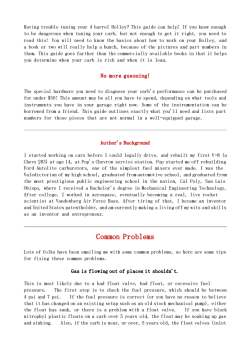
Having trouble tuning your 4 barrel Holley? This guide can help! If you know enoughto be dangerous when tuning your carb, but not enough to get it right, you need toread this! You will need to know the basics about how to work on your Holley, andabook ortwowillreallyhelpabunch,becauseof thepictures andpartnumbers inthem.Thisguidegoesfartherthanthecommerciallyavailablebooks inthatit helpsyou determine when your carb is rich and when it is lean.No more guessing!The special hardwareyou need todiagnose yourcarb'sperformancecan be purchasedforunders5o!Thisamountmaybeall youhavetospend,dependingonwhat toolsandinstruments you have in your garage right now. Some of the instrumentation can beborrowed from a friend. This guide outlines exactly what you'l need and lists partnumbers for those pieces that are not normal in a well-equipped garage.Author' s BackgroundI started working on cars before I could legallydrive, and rebuilt my first V-8 (aChevy283)atage14,atPop's Chevron service station.Pop startedme off rebuildingFord Autolite carburetors, one of the simplest fuel mixers ever made. I was theValedictorian of myhigh school, graduated fromautomotive school,and graduated fromthe most prestigious public engineering school in the nation, Cal Poly, San LuisObispo, where I received a Bachelor's degree in Mechanical Engineering Technology.After college, I worked in aerospace, eventuallybecoming a real,live rocketscientist at Vandenberg Air Force Base. After tiring of that, I became an inventorand United States patentholder, and am currently making aliving off my wits and skillsas an inventor and entrepreneur.Common ProblemsLotsof folkshavebeen emailingmewithsomecommonproblems,soherearesometipsforfixing these commonproblems.Gas is flowing out of places it shouldn't.This is most likely due to a bad float valve, bad float, or excessive fuelThe first step is to check the fuel pressure, which should be betweenpressure.4 psi and 7 psi.If thefuel pressure is correct (oryouhavenoreason to believethat it has changed on an existing setup such as an old stock mechanical pump), eitherIf youhave blackthefloat has sunk,orthereis aproblem with afloat valve.nitrophyl plastic floats on a carb over 5 years old, the float may be soaking up gasand sinking.Also, if the carb isnear, or over, 5 years old, the float valves (inlet
Having trouble tuning your 4 barrel Holley? This guide can help! If you know enough to be dangerous when tuning your carb, but not enough to get it right, you need to read this! You will need to know the basics about how to work on your Holley, and a book or two will really help a bunch, because of the pictures and part numbers in them. This guide goes farther than the commercially available books in that it helps you determine when your carb is rich and when it is lean. No more guessing! The special hardware you need to diagnose your carb's performance can be purchased for under $50! This amount may be all you have to spend, depending on what tools and instruments you have in your garage right now. Some of the instrumentation can be borrowed from a friend. This guide outlines exactly what you'll need and lists part numbers for those pieces that are not normal in a well-equipped garage. Author's Background I started working on cars before I could legally drive, and rebuilt my first V-8 (a Chevy 283) at age 14, at Pop's Chevron service station. Pop started me off rebuilding Ford Autolite carburetors, one of the simplest fuel mixers ever made. I was the Valedictorian of my high school, graduated from automotive school, and graduated from the most prestigious public engineering school in the nation, Cal Poly, San Luis Obispo, where I received a Bachelor's degree in Mechanical Engineering Technology. After college, I worked in aerospace, eventually becoming a real, live rocket scientist at Vandenberg Air Force Base. After tiring of that, I became an inventor and United States patentholder, and am currently making a living off my wits and skills as an inventor and entrepreneur. Common Problems Lots of folks have been emailing me with some common problems, so here are some tips for fixing these common problems. Gas is flowing out of places it shouldn't. This is most likely due to a bad float valve, bad float, or excessive fuel pressure. The first step is to check the fuel pressure, which should be between 4 psi and 7 psi. If the fuel pressure is correct (or you have no reason to believe that it has changed on an existing setup such as an old stock mechanical pump), either the float has sunk, or there is a problem with a float valve. If you have black nitrophyl plastic floats on a carb over 5 years old, the float may be soaking up gas and sinking. Also, if the carb is near, or over, 5 years old, the float valves (inlet
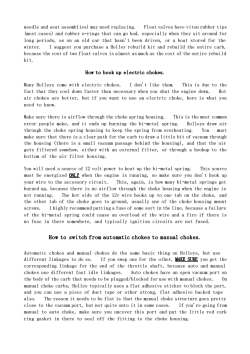
needleandseatassemblies)mayneedreplacing.Floatvalveshavevitonrubbertips(most cases) and rubber o-rings that can go bad, especially when they sit around forlong periods, as on an old car that hasn't been driven,or a boat stored for thewinter.I suggest you purchase a Holleyrebuildkit and rebuild the entire carb,becausethecostof twofloatvalvesisalmost asmuchasthecostof theentirerebuildkit.How to hook up electric chokes.ManyHolleys comewith electric chokes.Idon't likethem.This is due to thefact that they cool down faster than necessary when you shut the engine down.Hotair chokes are better, but if you want to use an electric choke, here is what youneed to know.Make sure there is airflow through the choke spring housing.Thisis themost commonerror people make, and it ends up burning the bi-metal spring.Holleys draw airYouthrough the choke spring housing to keep the spring from overheating.mustmake sure that there is a clear path for the carb to draw a little bit of vacuum throughthe housing (there is a small vacuum passage behind the housing), and that the airgets filtered somehow, either with an external filter,or through a hookup to thebottom of the air filter housing.You will need a source of 12 volt power to heat up the bi-metal spring.This sourcemust be energized ONLY when the engine is running, so make sure you don't hook upyourwiretotheaccessorycircuit.This,again,is howmanybi-metal springsgetburned up,because there is no airflow through the chokehousingwhen the engine isThehot sideof the12vwirehooksup toonetab on thechoke,andnot running.the other tab of the choke goes to ground, usually one of the choke housing mountscrews.Ihighlyrecommendputtingafuseof some sortin theline,because afailureof the bi-metal spring could cause an overload of the wire and a fire if there isno fuse in there somewhere, and typically ignition circuits are not fusedHowto switch from automatic chokesto manual chokes.Automatic chokes and manual chokes do the same basic thing on Holleys, but usedifferentlinkagesto doso.If youswap onefortheother,MAKESUREyougetthecorresponding linkage for the end of the throttle shaft, because auto and manualchokes use different fast idle linkages.Auto chokes havean open vacuumport onthe body of the carbthat needs to beplugged/blockedforuse with manual chokes.Onmanual choke carbs, Holley typically uses a flat adhesive sticker to block the port,and you can use a piece of duct tape or other strong, flat adhesive backed tapealso.The reason it needs to beflat is that the manual choke structure goes prettyclose to the vacuumport, but not quite onto it in some cases.If you're going frommanual to auto choke, make sure you uncover this port and put the little red corkring gasket in there to seal off the fitting to the choke housing
needle and seat assemblies) may need replacing. Float valves have viton rubber tips (most cases) and rubber o-rings that can go bad, especially when they sit around for long periods, as on an old car that hasn't been driven, or a boat stored for the winter. I suggest you purchase a Holley rebuild kit and rebuild the entire carb, because the cost of two float valves is almost as much as the cost of the entire rebuild kit. How to hook up electric chokes. Many Holleys come with electric chokes. I don't like them. This is due to the fact that they cool down faster than necessary when you shut the engine down. Hot air chokes are better, but if you want to use an electric choke, here is what you need to know. Make sure there is airflow through the choke spring housing. This is the most common error people make, and it ends up burning the bi-metal spring. Holleys draw air through the choke spring housing to keep the spring from overheating. You must make sure that there is a clear path for the carb to draw a little bit of vacuum through the housing (there is a small vacuum passage behind the housing), and that the air gets filtered somehow, either with an external filter, or through a hookup to the bottom of the air filter housing. You will need a source of 12 volt power to heat up the bi-metal spring. This source must be energized ONLY when the engine is running, so make sure you don't hook up your wire to the accessory circuit. This, again, is how many bi-metal springs get burned up, because there is no airflow through the choke housing when the engine is not running. The hot side of the 12v wire hooks up to one tab on the choke, and the other tab of the choke goes to ground, usually one of the choke housing mount screws. I highly recommend putting a fuse of some sort in the line, because a failure of the bi-metal spring could cause an overload of the wire and a fire if there is no fuse in there somewhere, and typically ignition circuits are not fused. How to switch from automatic chokes to manual chokes. Automatic chokes and manual chokes do the same basic thing on Holleys, but use different linkages to do so. If you swap one for the other, MAKE SURE you get the corresponding linkage for the end of the throttle shaft, because auto and manual chokes use different fast idle linkages. Auto chokes have an open vacuum port on the body of the carb that needs to be plugged/blocked for use with manual chokes. On manual choke carbs, Holley typically uses a flat adhesive sticker to block the port, and you can use a piece of duct tape or other strong, flat adhesive backed tape also. The reason it needs to be flat is that the manual choke structure goes pretty close to the vacuum port, but not quite onto it in some cases. If you're going from manual to auto choke, make sure you uncover this port and put the little red cork ring gasket in there to seal off the fitting to the choke housing
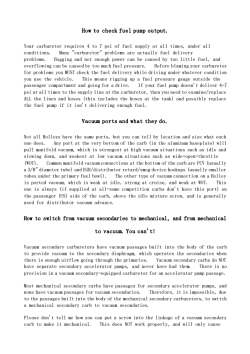
How to check fuel pump output.Your carburetor requires 4 to 7 psi of fuel supply at all times, under allMany"carburetor"problems are actually fuel deliveryconditions.problems.Bogging and not enough power can be caused by too little fuel, andoverflowingcanbecausedbytoomuchfuelpressure.Before blaming your carburetorforproblemsyouMusTcheck thefuel deliverywhiledrivingunderwhateverconditionyouuse the vehicle.This means rigging up a fuel pressure gauge outside thepassengercompartmentandgoingforadrive.Ifyourfuelpumpdoesn'tdeliver4-7psi at all times to the supply line at the carburetor, then you need to examine/replaceALL the lines and hoses (this includes the hoses at the tank) and possibly replacethe fuel pump if it isn't delivering enough fuel.Vacuum ports and what they do.Not all Holleys have the same ports, but you can tell by location and size what eachonedoes.Any port at the verybottom of the carb(inthe aluminumbaseplate)willpull manifold vacuum, which is strongest at high vacuum situations such as idle andslowing down, and weakest at low vacuum situations such as wide-open-throttle(wor).Common manifoldvacuum connections at thebottom of the carb are PCv (usuallya3/8"diametertube)andEGR/distributorretard/smogdevicehookups(usuallysmallertubesundertheprimaryfuelbowl).Theothertypeof vacuumconnection onaHolleyis ported vacuum, which is weak at idle, strong at cruise, and weak at woT.Thisone is always (if supplied at all-some competition carbs don't have this port) onthe passenger (Us) side of the carb, above the idle mixture screw, and is generallyused for distributor vacuum advance.How to switch from vacuum secondaries to mechanical, and from mechanicalto vacuum. You can't!Vacuum secondary carburetors have vacuum passages built into the body of the carbto provide vacuum to the secondary diaphragm, which operates the secondaries whenthereisenoughairflowgoing throughtheprimaries.Vacuum secondarycarbsdoNOThave separate secondary accelerator pumps, and never have had them.Thereis noprovision in a vacuum secondary-equipped carburetor for an accelerator pump passage.Most mechanical secondary carbs havepassages for secondaryaccelerator pumps, andnonehave vacuumpassagesfor vacuum secondaries.Therefore,itisimpossible,dueto the passages built into thebody of themechanical secondary carburetors,to switcha mechanical secondary carb to vacuum secondaries.Please don't tell me how you can put a screw into the linkage of a vacuum secondarycarb to make it mechanical.This does NOT work properly, and will only cause
How to check fuel pump output. Your carburetor requires 4 to 7 psi of fuel supply at all times, under all conditions. Many "carburetor" problems are actually fuel delivery problems. Bogging and not enough power can be caused by too little fuel, and overflowing can be caused by too much fuel pressure. Before blaming your carburetor for problems you MUST check the fuel delivery while driving under whatever condition you use the vehicle. This means rigging up a fuel pressure gauge outside the passenger compartment and going for a drive. If your fuel pump doesn't deliver 4-7 psi at all times to the supply line at the carburetor, then you need to examine/replace ALL the lines and hoses (this includes the hoses at the tank) and possibly replace the fuel pump if it isn't delivering enough fuel. Vacuum ports and what they do. Not all Holleys have the same ports, but you can tell by location and size what each one does. Any port at the very bottom of the carb (in the aluminum baseplate) will pull manifold vacuum, which is strongest at high vacuum situations such as idle and slowing down, and weakest at low vacuum situations such as wide-open-throttle (WOT). Common manifold vacuum connections at the bottom of the carb are PCV (usually a 3/8" diameter tube) and EGR/distributor retard/smog device hookups (usually smaller tubes under the primary fuel bowl). The other type of vacuum connection on a Holley is ported vacuum, which is weak at idle, strong at cruise, and weak at WOT. This one is always (if supplied at all-some competition carbs don't have this port) on the passenger (US) side of the carb, above the idle mixture screw, and is generally used for distributor vacuum advance. How to switch from vacuum secondaries to mechanical, and from mechanical to vacuum. You can't! Vacuum secondary carburetors have vacuum passages built into the body of the carb to provide vacuum to the secondary diaphragm, which operates the secondaries when there is enough airflow going through the primaries. Vacuum secondary carbs do NOT have separate secondary accelerator pumps, and never have had them. There is no provision in a vacuum secondary-equipped carburetor for an accelerator pump passage. Most mechanical secondary carbs have passages for secondary accelerator pumps, and none have vacuum passages for vacuum secondaries. Therefore, it is impossible, due to the passages built into the body of the mechanical secondary carburetors, to switch a mechanical secondary carb to vacuum secondaries. Please don't tell me how you can put a screw into the linkage of a vacuum secondary carb to make it mechanical. This does NOT work properly, and will only cause
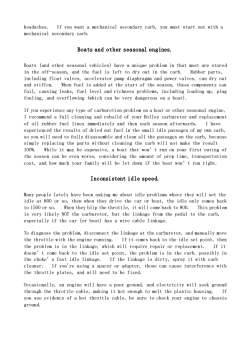
headaches.If you want a mechanical secondary carb, you must start out with amechanical secondary carb.Boats and other seasonal engines.Boats (and other seasonal vehicles) have a unique problem in that most are storedin the off-season, and the fuel is left to dry out in the carb.Rubber parts,including float valves, accelerator pump diaphragms and power valves, can dry outWhen fuel is added at the start of the season, these components canandstiffen.fail, causing leaks, fuel level and richness problems, including loading up, plugfouling, and overflowing (which can be very dangerous on a boat).If you experience any type of carburetion problem on a boat or other seasonal engine,I recommend a full cleaning and rebuild of your Holley carburetor and replacementof all rubber fuel lines immediately and then each season afterwards.I haveexperienced the results of dried out fuel in the small idle passages of my own carb,so you will need to fully disassemble and clean all the passages on the carb, becausesimply replacing the parts without cleaning the carb will not make the result100%.While it may be expensive,aboatthatwont run on your first outing oftheseasoncan.beevenworse,considerinamount ofpreptime,transportationthecost,andhowmuchyourfamilywillbelet down if the boat won' t run right.Inconsistent idle speed.Many people lately have been asking me about idle problems where they will set theidleat 8ooor so,thenwhentheydrivethecar orboat,the idleonlycomesbackto1500orso.Whentheyblipthethrottle,itwillcomebackto8oo.Thisproblemis very likely NoT the carburetor,but the linkage from the pedal to the carb,especiallyif thecar(or boat)has awire cablelinkage.To diagnose the problem, disconnect the linkage at the carburetor, and manually movethe throttle with the engine running.Ifitcomesbacktotheidlesetpoint,thenthe problem is in the linkage, which will require repair or replacement.If itdoesntcomebacktotheidlesetpoint,theproblemisinthecarb,possiblyinthe choke' s fast idle linkage.If the linkage is dirty,spray it with carbcleaner.If you're using a spacer or adapter, those can cause interference withthe throttle plates, and will need to be fixed.Occasionally, an engine will have a poor ground, and electricity will seek groundIfthrough the throttle cable,making it hot enough tomelt the plastic housing.you see evidence of a hot throttle cable, be sure to check your engine to chassisground
headaches. If you want a mechanical secondary carb, you must start out with a mechanical secondary carb. Boats and other seasonal engines. Boats (and other seasonal vehicles) have a unique problem in that most are stored in the off-season, and the fuel is left to dry out in the carb. Rubber parts, including float valves, accelerator pump diaphragms and power valves, can dry out and stiffen. When fuel is added at the start of the season, these components can fail, causing leaks, fuel level and richness problems, including loading up, plug fouling, and overflowing (which can be very dangerous on a boat). If you experience any type of carburetion problem on a boat or other seasonal engine, I recommend a full cleaning and rebuild of your Holley carburetor and replacement of all rubber fuel lines immediately and then each season afterwards. I have experienced the results of dried out fuel in the small idle passages of my own carb, so you will need to fully disassemble and clean all the passages on the carb, because simply replacing the parts without cleaning the carb will not make the result 100%. While it may be expensive, a boat that won’t run on your first outing of the season can be even worse, considering the amount of prep time, transportation cost, and how much your family will be let down if the boat won’t run right. Inconsistent idle speed. Many people lately have been asking me about idle problems where they will set the idle at 800 or so, then when they drive the car or boat, the idle only comes back to 1500 or so. When they blip the throttle, it will come back to 800. This problem is very likely NOT the carburetor, but the linkage from the pedal to the carb, especially if the car (or boat) has a wire cable linkage. To diagnose the problem, disconnect the linkage at the carburetor, and manually move the throttle with the engine running. If it comes back to the idle set point, then the problem is in the linkage, which will require repair or replacement. If it doesn’t come back to the idle set point, the problem is in the carb, possibly in the choke’s fast idle linkage. If the linkage is dirty, spray it with carb cleaner. If you're using a spacer or adapter, those can cause interference with the throttle plates, and will need to be fixed. Occasionally, an engine will have a poor ground, and electricity will seek ground through the throttle cable, making it hot enough to melt the plastic housing. If you see evidence of a hot throttle cable, be sure to check your engine to chassis ground
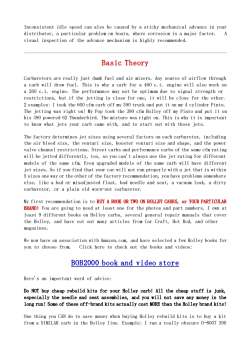
Inconsistent idle speed can alsobe caused bya sticky mechanical advance in yourAdistributor, a particular problem on boats, where corrosion is a major factor.visual inspection of the advance mechanism is highly recommended.Basic TheoryCarburetors are really just dumb fuel and air mixers. Any source of airflow throughacarbwill drawfuel.Thisiswhyacarbfor a460c.i.enginewill alsoworkona 260 c.i. engine. The performance may not be optimum due to signal strength orrestrictions,butif thejettingis closeforone,it will be close forthe other.2 examples: I took the 600 cfm carb off my 390 truck and put it on my 4 cylinder Pinto.Thejetting was right on!MyPop took the390 cfmHolley off myPintoandput it onhis390 powered 62Thunderbird.Themixture wasright on.This is whyit is importantto know what jets your carb came with, and to start out with those jets.The factory determines jet sizes using several factors on each carburetor, includingthe air bleed size, the venturi size, booster venturi size and shape, and the powervalve channelrestrictions.Street carbs and performance carbs of the same cfmratingwill be jetted differently, too, so you can't always use the jet rating for differentmodelsofthesamecfm.Evenupgradedmodelsofthesamecarbwillhavedifferentjet sizes.Soifyoufind that your carwill notrunproperlywitha jetthat iswithin5sizesonewayortheotherof thefactoryrecommendation,youhaveproblemssomewhereelse,like a bad or misadjusted float, bad needle and seat,a vacuum leak,a dirtycarburetor, or a plain old worn-out carburetor.My first recommendation is to BUYABOOK ORTWO ON HOLLEY CARBS, or YOURPARTICULARBRAND! You are going to need at least one for the photos and part numbers. I own atleast 9 different books on Holley carbs, several general repair manuals that covertheHolley,and have cut out many articles from Car Craft,HotRod, and othermagazines.WenowhaveanassociationwithAmazon.com,andhaveselectedafewHolleybooksforClickheretocheckoutthebooksandvideos:youto choosefrom.B0B2000 book and video storeHere's an important word of advice:Do NoT buy cheap rebuild kits for your Holley carb! All the cheap stuff is junk,especially the needle and seat assemblies, and you will not save any money in thelong run! Some of these off-brand kits actually cost MoRE than the Holley brand kits!OnethingyouCANdotosavemoneywhenbuyingHolleyrebuildkitsistobuyakitfrom a SIMILAR carb in the Holley line.Example:I run a really obscure 0-8007 390
Inconsistent idle speed can also be caused by a sticky mechanical advance in your distributor, a particular problem on boats, where corrosion is a major factor. A visual inspection of the advance mechanism is highly recommended. Basic Theory Carburetors are really just dumb fuel and air mixers. Any source of airflow through a carb will draw fuel. This is why a carb for a 460 c.i. engine will also work on a 260 c.i. engine. The performance may not be optimum due to signal strength or restrictions, but if the jetting is close for one, it will be close for the other. 2 examples: I took the 600 cfm carb off my 390 truck and put it on my 4 cylinder Pinto. The jetting was right on! My Pop took the 390 cfm Holley off my Pinto and put it on his 390 powered 62 Thunderbird. The mixture was right on. This is why it is important to know what jets your carb came with, and to start out with those jets. The factory determines jet sizes using several factors on each carburetor, including the air bleed size, the venturi size, booster venturi size and shape, and the power valve channel restrictions. Street carbs and performance carbs of the same cfm rating will be jetted differently, too, so you can't always use the jet rating for different models of the same cfm. Even upgraded models of the same carb will have different jet sizes. So if you find that your car will not run properly with a jet that is within 5 sizes one way or the other of the factory recommendation, you have problems somewhere else, like a bad or misadjusted float, bad needle and seat, a vacuum leak, a dirty carburetor, or a plain old worn-out carburetor. My first recommendation is to BUY A BOOK OR TWO ON HOLLEY CARBS, or YOUR PARTICULAR BRAND! You are going to need at least one for the photos and part numbers. I own at least 9 different books on Holley carbs, several general repair manuals that cover the Holley, and have cut out many articles from Car Craft, Hot Rod, and other magazines. We now have an association with Amazon.com, and have selected a few Holley books for you to choose from. Click here to check out the books and videos: BOB2000 book and video store Here's an important word of advice: Do NOT buy cheap rebuild kits for your Holley carb! All the cheap stuff is junk, especially the needle and seat assemblies, and you will not save any money in the long run! Some of these off-brand kits actually cost MORE than the Holley brand kits! One thing you CAN do to save money when buying Holley rebuild kits is to buy a kit from a SIMILAR carb in the Holley line. Example: I run a really obscure 0-8007 390
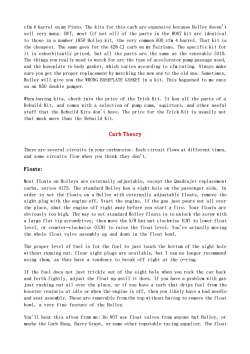
cfm4barrel onmyPinto.Thekitsforthiscarb areexpensivebecauseHolleydoesn'tsell very many. BUT, most (if not all) of the parts in the 8007kit are identicalto those in anumber 1850 Holleykit,the verycommon 600 cfm4 barrel.That kit isthe cheapest.The same goes for the 428 CJ carb on my Fairlane.The specific kit forit isexhorbitantlypriced,butall thepartsarethe same asthevenerable33loThe things you reallyneed to watch for are the type of accelerator pump passage used,and the baseplate to bodygasket, which variesaccording to cfmrating.Always makesure you get the proper replacement by matching the new one to the old one. Sometimes,Holleywill give youtheWRONGBASEPLATEGASKETin a kit.Thishappenedtomeonceonan 850doublepumper.When buying kits, check into the price of the Trick Kit.It has all the parts of aRebuild Kit, and comes with a selection of pump cams, squirters, and other usefulstuff that the Rebuild Kits don't have. The price for the Trick Kit is usually notthat much more than the Rebuild Kit.Carb TheoryThere are several circuits in your carburetor. Each circuit flows at different times,and somecircuits flowwhen you thinkthey don't.Floats:Most floats on Holleys are externally adjustable, except the Quadrajet replacementcarbs, series 4175. The standard Holley has a sight hole on the passenger side.Inorder to set the floats on a Holley with externally adjustable floats, remove thesight plugwith the engine off. Start the engine.If the gas just pours out all overthe place, shut the engine off right away before you start a fire. Your floats areobviously toohigh.Theway to set standardHolley floats is tounlock thescrewwithalarge flat tip screwdriver,thenmove the5/8 hexnut clockwise (Cw)to lower floatlevel, or counter-clockwise (cCw) to raise the float level. You're actually movingthewhole floatvalveassembly up anddownin thefloat bowl.The proper level of fuel is for the fuel to just touch the bottom of the sight holewithoutrunning out.Clear sight plugs are available,but I canno longer recommendusing them, as they have a tendency to break off right at the o-ring.If the fuel does not just trickle out of the sight hole when you rock the car backand forth lightly, adjust the float up until it does.If you have a problem with gasjustrushingout all overtheplace,or if youhaveacarbthat dripsfuel from theboosterventurisat idleorwhen the engineis off,thenyou likelyhavea bad needleand seat assembly.These are removablefrom the top without having to removethe floatbowl,averyfinefeature of the Holley.You'1l hear this often from me:Do NoT use float valves from anyone but Holley,ormaybethe Carb Shop,Barry Grant,or some other reputableracing supplier.Thefloat
cfm 4 barrel on my Pinto. The kits for this carb are expensive because Holley doesn't sell very many. BUT, most (if not all) of the parts in the 8007 kit are identical to those in a number 1850 Holley kit, the very common 600 cfm 4 barrel. That kit is the cheapest. The same goes for the 428 CJ carb on my Fairlane. The specific kit for it is exhorbitantly priced, but all the parts are the same as the venerable 3310. The things you really need to watch for are the type of accelerator pump passage used, and the baseplate to body gasket, which varies according to cfm rating. Always make sure you get the proper replacement by matching the new one to the old one. Sometimes, Holley will give you the WRONG BASEPLATE GASKET in a kit. This happened to me once on an 850 double pumper. When buying kits, check into the price of the Trick Kit. It has all the parts of a Rebuild Kit, and comes with a selection of pump cams, squirters, and other useful stuff that the Rebuild Kits don't have. The price for the Trick Kit is usually not that much more than the Rebuild Kit. Carb Theory There are several circuits in your carburetor. Each circuit flows at different times, and some circuits flow when you think they don't. Floats: Most floats on Holleys are externally adjustable, except the Quadrajet replacement carbs, series 4175. The standard Holley has a sight hole on the passenger side. In order to set the floats on a Holley with externally adjustable floats, remove the sight plug with the engine off. Start the engine. If the gas just pours out all over the place, shut the engine off right away before you start a fire. Your floats are obviously too high. The way to set standard Holley floats is to unlock the screw with a large flat tip screwdriver, then move the 5/8 hex nut clockwise (CW) to lower float level, or counter-clockwise (CCW) to raise the float level. You're actually moving the whole float valve assembly up and down in the float bowl. The proper level of fuel is for the fuel to just touch the bottom of the sight hole without running out. Clear sight plugs are available, but I can no longer recommend using them, as they have a tendency to break off right at the o-ring. If the fuel does not just trickle out of the sight hole when you rock the car back and forth lightly, adjust the float up until it does. If you have a problem with gas just rushing out all over the place, or if you have a carb that drips fuel from the booster venturis at idle or when the engine is off, then you likely have a bad needle and seat assembly. These are removable from the top without having to remove the float bowl, a very fine feature of the Holley. You'll hear this often from me: Do NOT use float valves from anyone but Holley, or maybe the Carb Shop, Barry Grant, or some other reputable racing supplier. The float
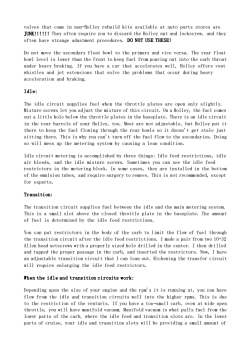
valves that come in non-Holley rebuild kits available at auto parts stores areJUNK!!!!!! They often require you to discard the Holley nut and lockscrew, and theyoften have strange adustment procedures. DO NOT USE THESE!Do not move the secondary float bowl to the primary and vice versa. The rear floatbowl level is lower than the front tokeep fuel from pouring out intothe carb throatunder heavy braking. If you have a car that accelerates well, Holley offers ventwhistles and jet extensions that solve the problems that occur during heavyacceleration and braking.Idle:The idle circuit supplies fuel when the throttle plates are open only slightly.Mixture screws let you adjust the mixture of this circuit. On a Holley, the fuel comesout a little hole below the throttle plates in the baseplate. There is an idle circuitin the rear barrels of your Holley, too. Most are not adjustable, but Holley put itthere to keep the fuel flowing through the rear bowls so it doesn't get stale justsitting there.This is why you can't turn off the fuel flowto the secondaries. Doingso will mess up the metering system by causing a lean condition.Idle circuit metering is accomplished by three things:Idlefeed restrictions, idleair bleeds,and the idle mixture screws. Sometimes you can see the idle feedrestrictors in the metering block. In some cases, they are installed in the bottomof the emulsion tubes, and require surgery to remove. This is not recommended, exceptfor experts.Transition:The transition circuit supplies fuel between the idle and the main metering system.This is a small slot above the closed throttle plate in the baseplate.The amountoffuelisdeterminedbytheidlefeedrestrictions.You can put restrictors in the body of the carb to limit the flow of fuel throughthetransition circuit after the idlefeedrestrictions.Imadea pairfromtwolo-32Allenhead setscrews withaproperlysizedholedrilled inthe centerI then drilledand tapped the proper passage in the carb, and inserted the restrictors. Now, I havean adjustable transition circuit that I can lean out. Richening the transfer circuitwill require enlarging the idle feed restrictors.When the idle and transition circuits work:Depending upon the size of your engine and the rpm' s it is running at, you can haveflow from the idle and transition circuits well into the higher rpms. This is dueto the restriction of theventuris.If youhaveatoo-small carb,evenat wideopenthrottle,youwillhavemanifoldvacuum.Manifoldvacuumiswhatpullsfuelfromthelower parts of thecarb,where the idlefeed and transitionslots are.In thelowerparts of cruise, your idle and transition slots will be providing a small amount of
valves that come in non-Holley rebuild kits available at auto parts stores are JUNK!!!!!! They often require you to discard the Holley nut and lockscrew, and they often have strange adustment procedures. DO NOT USE THESE! Do not move the secondary float bowl to the primary and vice versa. The rear float bowl level is lower than the front to keep fuel from pouring out into the carb throat under heavy braking. If you have a car that accelerates well, Holley offers vent whistles and jet extensions that solve the problems that occur during heavy acceleration and braking. Idle: The idle circuit supplies fuel when the throttle plates are open only slightly. Mixture screws let you adjust the mixture of this circuit. On a Holley, the fuel comes out a little hole below the throttle plates in the baseplate. There is an idle circuit in the rear barrels of your Holley, too. Most are not adjustable, but Holley put it there to keep the fuel flowing through the rear bowls so it doesn't get stale just sitting there. This is why you can't turn off the fuel flow to the secondaries. Doing so will mess up the metering system by causing a lean condition. Idle circuit metering is accomplished by three things: Idle feed restrictions, idle air bleeds, and the idle mixture screws. Sometimes you can see the idle feed restrictors in the metering block. In some cases, they are installed in the bottom of the emulsion tubes, and require surgery to remove. This is not recommended, except for experts. Transition: The transition circuit supplies fuel between the idle and the main metering system. This is a small slot above the closed throttle plate in the baseplate. The amount of fuel is determined by the idle feed restrictions. You can put restrictors in the body of the carb to limit the flow of fuel through the transition circuit after the idle feed restrictions. I made a pair from two 10-32 Allen head setscrews with a properly sized hole drilled in the center. I then drilled and tapped the proper passage in the carb, and inserted the restrictors. Now, I have an adjustable transition circuit that I can lean out. Richening the transfer circuit will require enlarging the idle feed restrictors. When the idle and transition circuits work: Depending upon the size of your engine and the rpm's it is running at, you can have flow from the idle and transition circuits well into the higher rpms. This is due to the restriction of the venturis. If you have a too-small carb, even at wide open throttle, you will have manifold vacuum. Manifold vacuum is what pulls fuel from the lower parts of the carb, where the idle feed and transition slots are. In the lower parts of cruise, your idle and transition slots will be providing a small amount of
按次数下载不扣除下载券;
注册用户24小时内重复下载只扣除一次;
顺序:VIP每日次数-->可用次数-->下载券;
- 《机器维修工程学》课程授课教案(英文)How Turbochargers Work.doc
- 《机器维修工程学》课程授课教案(石河子大学:赵永满).doc
- 《机器维修工程学》课程教学大纲 Maintenance Engineering.pdf
- 《机械制造基础》课程PPT教学课件(机械工程材料)第八章 有色金属及其合金.ppt
- 《机械制造基础》课程PPT教学课件(机械工程材料)第七章 铸铁.ppt
- 《机械制造基础》课程PPT教学课件(机械工程材料)第一章 材料的性能.ppt
- 《机械制造基础》课程PPT教学课件(机械工程材料)第十一章 复合材料.ppt
- 《机械制造基础》课程PPT教学课件(机械工程材料)第十章 陶瓷材料.ppt
- 《机械制造基础》课程PPT教学课件(机械工程材料)第九章 高分子材料.ppt
- 《机械制造基础》课程PPT教学课件(机械工程材料)总复习.ppt
- 《机械制造基础》课程教学资源(复习资料)疑难问题解答(一).ppt
- 《机械制造基础》课程教学资源(复习资料)工程材料学习指导.doc
- 《机械制造基础》课程教学资源(复习资料)疑难问题解答(三).ppt
- 《机械制造基础》课程教学资源(复习资料)疑难问题解答(二).doc
- 《机械制造基础》课程教学大纲(一)Machine Manufacturing foundation(适用专业:机械设计制造及其自动化).doc
- 《机械制造基础》课程教学大纲(二)Machine Manufacturing foundation(适用专业:机械设计制造及其自动化).doc
- 《机械制造基础》课程教学大纲 Machine Manufacturing foundation(适用专业:工业工程).doc
- 《机械制造基础》课程教学大纲(二)Machine Manufacturing foundation(适用专业:农机).doc
- 《机械制造基础》课程教学大纲(一)Machine Manufacturing foundation(适用专业:农机).doc
- 《机械制造基础》课程教学大纲 Machine Manufacturing foundation(适用专业:电气工程及其自动化).doc
- 《机器维修工程学》课程授课教案(英文)How car engine work.doc
- 《机器维修工程学》课程授课教案(英文)How Automatic Transmissions Work.doc
- 《机器维修工程学》课程授课教案(英文)Motorcycle Carburetor Theory 101.doc
- 《机器维修工程学》课程教学课件(讲稿)测点的设置和传感器的安装.pdf
- 《机器维修工程学》课程教学课件(讲稿)滚动轴承故障诊断 Rolling Element Bearing Diagnosis.pdf
- 《机器维修工程学》课程教学课件(讲稿)机器振动特征分析(3/3).pdf
- 《机器维修工程学》课程教学课件(讲稿)设备诊断技术的应用和发展.pdf
- 《机器维修工程学》课程教学课件(PPT讲稿)设备状态监测与故障诊断讲座.ppt
- 《机器维修工程学》课程教学课件(讲稿)机器振动特征分析(1/3).pdf
- 《机器维修工程学》课程教学课件(讲稿)机器振动特征分析(2/3).pdf
- 《机器维修工程学》课程教学课件(PPT讲稿)发动机压缩系的修理.ppt
- 《机器维修工程学》课程教学课件(PPT讲稿)设备修理和零件修复技术-2/2.ppt
- 《机器维修工程学》课程教学课件(PPT讲稿)设备修理和零件修复技术-1/2.ppt
- 《机器维修工程学》课程教学课件(PPT讲稿)修理前的准备工作.ppt
- 《机器维修工程学》课程教学课件(PPT讲稿)第一章 故障诊断学(2/3).ppt
- 《机器维修工程学》课程教学课件(PPT讲稿)第一章 故障诊断学(1/3).ppt
- 《机器维修工程学》课程教学课件(PPT讲稿)第二章 机械零件生效分析.ppt
- 《机器维修工程学》课程教学课件(PPT讲稿)第三章 产品的极限技术状态.ppt
- 《机器维修工程学》课程教学课件(PPT讲稿)第一章 故障诊断学(3/3).ppt
- 《机器维修工程学》课程教学课件(PPT讲稿)机械设备的故障及可靠性理论.ppt
